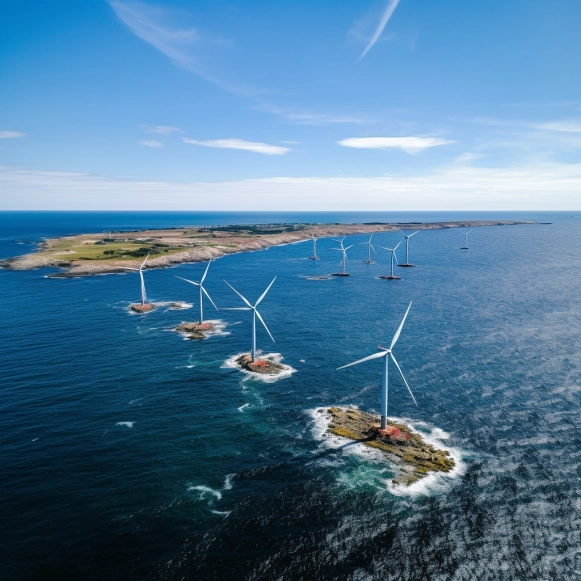Despite setbacks, states are still counting on offshore wind

East Coast leaders planning new strategies, investments
East Coast states’ plans to build massive new offshore wind farms have been hampered in recent months by bad economic news, canceled contracts, and newfound uncertainty about the projects officials are counting on to meet their clean energy targets.
Despite the setbacks, state officials say they have no plans to scale back their offshore wind ambitions. They’re developing new strategies and investments to help the industry get off to a good start. And they are sticking to mandates that offshore wind account for a significant portion of their future power supply.
“New Jersey is committed to wind energy, and doubling down is the answer,” said New Jersey state Sen. Bob Smith, a Democrat who chairs the Environment and Energy Committee, following the cancellation of two projects off the state’s coast by a developer. “I don’t think we have much of a choice.” Offshore wind has the potential to be an endless source of energy.”
Some developers who have recently abandoned long-planned projects cite interest rates, inflation, and supply chain issues, claiming that the price they agreed to sell their energy at no longer justifies their costs. States have resisted the companies’ requests for additional subsidies or price increases, putting additional projects at risk.
According to some observers, in order for states to meet their clean energy targets, governments — and public utility customers — may have to pay more than they had planned.
“State legislators are in a bind here,” said Carlos Ochoa, ocean program manager for the National Caucus of Environmental Legislators, a forum for state legislators. “If they don’t want to renegotiate with those projects, they’re going to have a delay in the construction of the projects and put in jeopardy their mandates.”
Earlier this year, developers in Massachusetts canceled two projects, claiming they could not complete the work under the original agreement. The state is seeking new bids for those projects, which could cost twice as much as the original price, according to state Sen. Julian Cyr, a Democrat who has advocated for offshore wind in his Cape Cod district.
As a result, Massachusetts has joined forces with Connecticut and Rhode Island to seek 6 gigatonnes of offshore wind power — enough to power 2 million homes — by allowing bidders to submit multistate proposals.
“We’re going to look back and say this was a really positive outcome of this unfortunate period,” Katie Dykes, commissioner of Connecticut’s Department of Energy and Environmental Protection, said. “It will allow us to secure lower prices through economies of scale, and to share the cost of individual projects.”
Dykes added that states in the region are also discussing joint investments in transmission infrastructure, and that the slowdown in project construction has been used to align technical transmission standards to ensure power from offshore turbines can move throughout the region.
State regulators in New York announced that they would expedite the process of soliciting new offshore wind proposals, in part to backfill projects that developers are expected to cancel. The state announced a $300 million investment last month to build facilities to manufacture turbine blades and other components.
“New York is taking an active, not a passive, role in addressing the industry’s challenges,” said Doreen Harris, president and CEO of the New York State Energy Research and Development Authority. “We believe we can solve for all these variables.”
State leaders on the West Coast are also pushing hard for offshore wind development. The deeper waters of the Pacific Ocean necessitate the use of floating wind turbines, a technology that is still being developed. As a result, projects in places like California aren’t as close to completion, and it’s unclear whether the current challenges will have an impact on the industry’s Pacific expansion.
Setbacks
Seven states along the Atlantic Coast have committed to sourcing nearly 43 gigatonnes of offshore wind power by 2040. That is enough to power approximately 14 million homes. These mandates triggered a frenzy of federal ocean leases, developer permitting applications, and state investments in supply chains and ports — strategies that have been in the works for years and have put states on the verge of putting turbines in the water.
However, that momentum was slowed when several projects that were supposed to serve as the industry’s launchpad were canceled. In New Jersey, Danish developer rsted announced last month that it was canceling two projects totaling 2.2 gigatonnes of power. Rising interest rates, inflation, and supply chain issues were cited by the company. This announcement came on the heels of three more cancellations in Massachusetts and Connecticut, totaling 3.2 gigatonnes.
Meanwhile, New York regulators rejected a petition from wind companies last month to provide more state subsidies to four offshore projects — funding that developers claimed was required to complete contracts totaling 4.2 gigatonnes.
And some projects have faced opposition from local communities concerned about sightlines or fishing, as well as misinformation from oil industry-backed groups claiming offshore wind harms whales.
The canceled and threatened projects account for more than half of the offshore wind capacity under contract with state regulators. Despite requests from developers to renegotiate contracts, states have been hesitant to do so, fearful of raising rates on consumers.
According to observers, if states and developers cannot reach an agreement on prices, more companies may cancel their contracts. This would force states to restart the bidding process, pushing back their offshore wind deployment timelines even further.
According to Timothy Fox, a vice president at ClearView Energy Partners, LLC, an independent research firm, companies will likely seek higher prices during the rebidding process. Those bids may conflict with state regulators’ duty to provide consumers with reasonable rates, he said, raising the possibility that some bids will be rejected.
Long term, Fox noted, “state policies that represent the primary drivers for offshore wind today remain stable.”
State officials say the recent difficulties are hiccups that will slow their progress but will not jeopardize offshore wind’s place in their energy future.
“There’s no denying the challenges the industry is facing right now,” said Dykes, the Connecticut agency’s commissioner. “However, we have some of the best offshore wind resources in the world just off our coast, and we have some ambitious decarbonization targets.” Those fundamentals are as relevant today as they were in 2018.”
The recent cancellations, according to Walt Musial, principal engineer at the National Renewable Energy Laboratory and a leading offshore wind expert, may jeopardize President Joe Biden’s goal of reaching 30 gigatonnes of offshore wind capacity nationwide by 2030. Currently, the country has almost no offshore wind generation, though several commercial projects are nearing completion. State mandates, on the other hand, many of which take effect in 2035 or 2040, are still within reach, according to Musial.
“When you look at the choices they have for renewable energy development in those regions, offshore wind almost has to be part of that mix,” he went on to say. “The exact date that this happens on isn’t as important as whether they follow through with offshore wind development.”
The state’s mandate of 5.6 gigatonnes of offshore wind power by 2035, according to Cyr, is attainable, “but the timeline is just much more condensed.” All of the complicating factors add up to make these projects more difficult to complete.”
State efforts
New Jersey has committed to achieving 11 gigatonnes of offshore wind capacity by 2040, and state lawmakers have made significant investments to construct a port capable of handling massive turbines and loading them onto ships. Despite the bad news from rsted, state leaders believe their efforts will be rewarded.
“We picked the wrong team, but we’re now actively looking for the right team,” Smith, the state senator, explained. “We’re going to find a wind vendor who will be able to do the job.” It’s going to be a huge industry.”
Smith stated that lawmakers are working to improve the state’s grid in order to make it easier for offshore wind to connect to transmission lines, and that they are pursuing federal funds from the Inflation Reduction Act to help the industry. The state’s mandate for offshore wind procurement by 2040 is “possible, but it’s harder,” he said.
New York announced last month that it had awarded 4 gigatonnes of new offshore wind contracts. According to Harris, the new contracts demonstrate that developers remain optimistic about the industry’s future in New York.
Meanwhile, in September, nine East Coast states and four federal agencies agreed to collaborate on ports, manufacturing facilities, and workforce development.
“It’s become more clear that the industry will not establish in every state, but the ways in which we can become complementary to one another has become a strong focus,” Mr. Harris said.
Musial, the offshore wind expert, mentioned that a 2.6 gigatonne wind farm in Virginia has received federal approval. Other projects in Maryland and Delaware, he said, appear to be on track.
“A lot of these economic headwinds we’re talking about right now were totally unforeseen,” he said. However, in the long run, “the alternatives [to offshore wind] aren’t any cheaper.”
States Newsroom, a national nonprofit news organization focused on state policy, owns Stateline.





